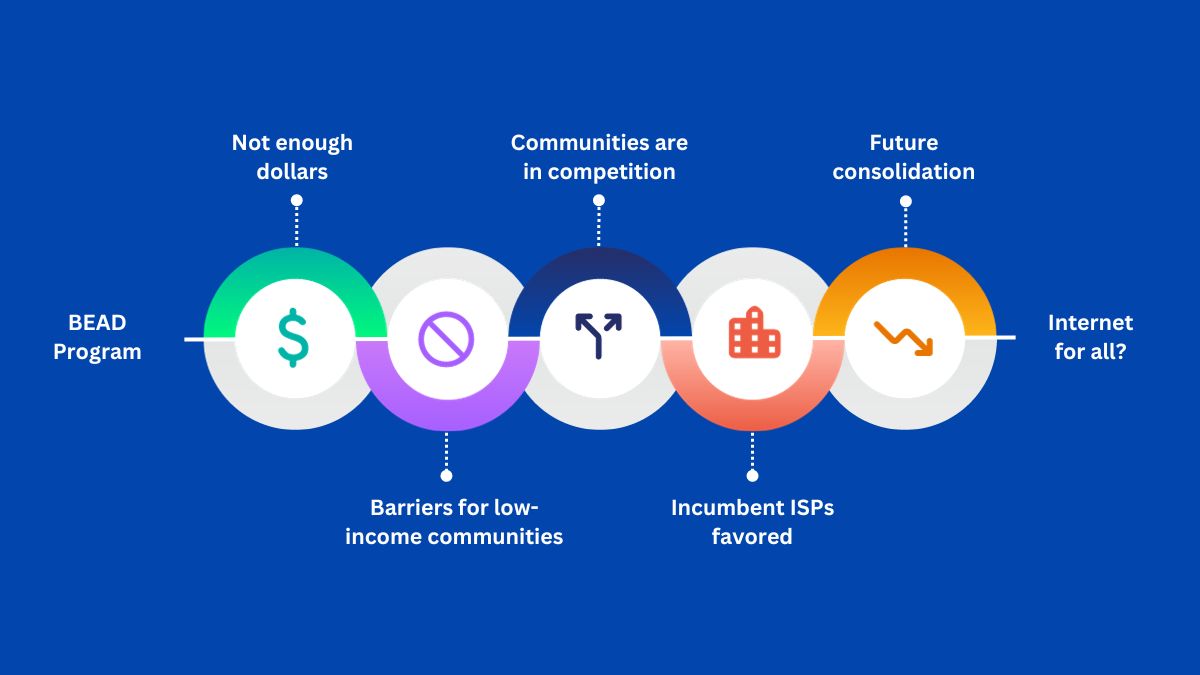Five reasons BEAD alone won’t deliver internet for all
And why impact finance and philanthropy must step in

As anyone who has ever made a new year’s resolution knows: good intention and big ambition without a realistic plan are a one-way ticket to ghosting the gym, chain-eating cheetos, and doom-scrolling the news by February 1st.
This year, the first Broadband Equity Access and Deployment (BEAD) grants will go out — an ambitious $42B subsidy program to build broadband infrastructure to close America’s digital divide. While excited and hopeful, I’m not alone in worrying that there is a significant gap between BEAD’s ambition and what it will likely deliver.
We all want President Biden’s promise to be true: BEAD will “connect every person in America to reliable high-speed Internet by 2030”. That’s why we’re worried communities might be set up for disappointment. Many leaders in philanthropy I speak to believe BEAD will be sufficient to close the digital divide, and that there’s no need for their funding.
But BEAD alone is not enough. If we don’t bust that myth soon, we risk leaving yet another generation behind. 2024 could be the turning point for broadband, but we need impact finance and philanthropy to step in and play roles only they can.
5 reasons BEAD alone won’t close the digital divide:
1. Not enough dollars to close the gap
I’ve seen a wide range of cost estimates for connecting America’s remaining un(der)served communities: from BEAD’s $42B being *just* enough (assuming all public funding is perfectly spent) to ~$200B for symmetrical gigabit fiber. The truth, as always, is somewhere in between.
There are good reasons to look critically at the low-end estimates. For a start, cost models are typically based on past project data which, by definition, under-represent under-served communities (can’t include data that doesn’t exist). These yet-to-be-built projects tend to be the most expensive. Then there’s inflation, taxes, and shortages of materials/labor that continue to erode how far a dollar goes. And what about the assumption that BEAD dollars will be spent perfectly? That has never happened in the history of infrastructure funding and there’s no reason to think that this time will be different.
Finally, and most importantly, if BEAD is a once-in-a-lifetime opportunity, we should not be ok with un(der)served communities getting the “just enough”. Why not build infrastructure for the future? By the time these projects are done, the 100/20 Mbps speed standard set by BEAD will be stale.
So no, BEAD will not be enough.
2. Requirements risk shutting out low-income communities
Despite herculean efforts, maps continue to undercount the scale of America’s broadband gaps. The bigger problem is that communities carry the burden of correcting them.
Too many low-income communities in most need are not resourced to navigate the complex and technical challenge process. Community anchor institutions (already strained) are required to aggregate and submit challenges; residents are not allowed to. We’ve already seen this go wrong: in California, maps show Beverly Hills is in more need than South Central Los Angeles for public funding. Similar dynamics are playing out nationally.
BEAD is complex. From navigating the challenge process, to finding a fair ISP partner and securing capital matches, communities are asked to do too much with too little. The likely consequence? Historically marginalized communities with the most need will receive the least support.
3. A seller’s market puts communities in competition
The pending wave of BEAD funding has un(der)served communities across the country fervently searching for ISP partners. That’s great for the supply-side: network builders, construction materials, labor, etc are in demand. But when internet demand outstrips internet supply by this magnitude, there will be haves and have nots.
I’ve seen this story enough times to know how it ends. We’re already seeing it play out: “Why should I build internet for your community first? This other community is offering me XYZ. Can you beat that?” Service providers have their pick. The result? The lowest-income, most in need of funding will again be last in line.
4. Requirements favor incumbent ISPs
As others have pointed out, BEAD rules are complex, with applicants having to navigate a litany of financial and operational requirements which differ from state to state. While this complexity is well intentioned (avoiding taxpayer dollars going to ISPs that can’t perform…see RDOF), it has the twin effect of shutting out many small and community-centric providers that are best positioned to deliver quality broadband to underserved Americans.
Between capital requirements (even with recent changes), workforce requirements (prematurely securing subcontractors for applications), and the considerable back-office needed to manage grant compliance, it’s enough to make even the most seasoned federal grants management expert pause. Community-centric ISPs are well positioned to deliver low-cost, high-quality internet, but risk getting tangled up in the red tape the big players thrive in.
The risk? Knee-jerking to disqualify smaller ISPs with a broad brush rather than understanding local nuances. The likely result? The lion’s share of funding will go to the same incumbents that have left millions of American families with inadequate access (despite billions in public subsidies) and have a record of perpetuating digital redlining.
5. Private equity is setting the stage for consolidation
Private equity has raised billions to invest in publicly subsidized broadband infrastructure (top 50 funds raising an average of $2.5B). Many openly talk about the pending consolidation in 3-5 years. What’s that mean? The sale of network assets that rolls up the ownership of all this fiber being built. To whom? Mostly to incumbents or other equity investors looking to maximize returns (read: extractive from already vulnerable communities). And with a de facto local monopoly, there’s little to stop them. Lest we forget the risks of privatizing essential infrastructure: Chicago parking meters still offer a cautionary tale.
How is this relevant for communities? Be wary of solving today’s need for connectivity with a short-term deal at the risk of tomorrow’s sustainability. You don’t want to find yourselves in 7-10 years facing unaffordable prices for eroding quality.
Crowding in the right partners
BEAD is a great start, with the right intentions and ambitions. But it won’t be enough without a realistic plan. Historically marginalized communities need help to:
- Find trusted partners and advocates;
- Understand others’ hidden agendas and incentives;
- Translate the technical jargon into plain english; and
- Structure the right deal with the right capital.
We need impact finance and philanthropy to jump in with both feet. Far from being crowded out, BEAD is an urgent call to those who haven’t yet engaged with digital equity to provide the resources, advocacy, and partnerships to make universal internet access a reality. That’s a worthy 2024 resolution to rally around.
Keep in touch
To learn more about our work follow us on social media, subscribe to our newsletter, and write to us anytime at info@connecthumanity.fund.
